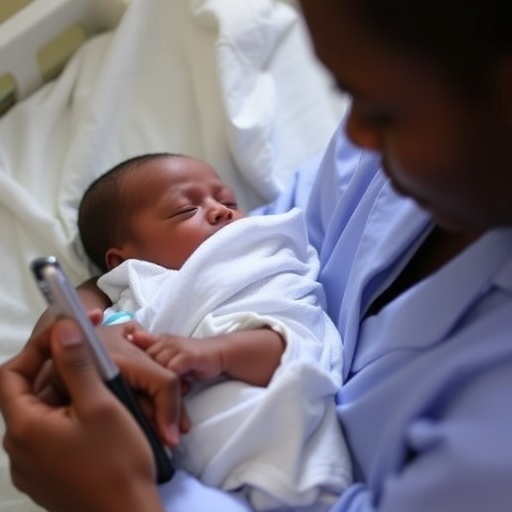In a groundbreaking study published in the renowned journal BMC Pediatrics, researchers have unveiled significant insights into neonatal hypothermia, a critical yet often overlooked condition affecting newborns globally. Neonatal hypothermia is defined as a body temperature below the normal range, which can pose severe health risks to newborns, particularly in low-resource settings where access to warming facilities may be limited. In this cross-sectional study, Akao, Nalwadda, Epuitai, and their colleagues focused on understanding the prevalence and associated factors of hypothermia among healthy term neonates in a peri-urban hospital in Northern Uganda, a region marked by unique environmental and socio-economic challenges.
The researchers conducted a meticulous examination involving 1,000 healthy term neonates over a specified period. The primary goal was to determine how frequently neonatal hypothermia occurred, as well as to identify the underlying factors contributing to the incidents. In regions like Northern Uganda, where temperatures can fluctuate significantly, these factors can include ambient temperature, maternal education regarding neonatal care, and availability of appropriate medical infrastructure. The findings of this study are not only vital for local healthcare providers but also hold implications for global practices concerning newborn care.
The results painted a worrisome picture. The team found that approximately 40% of the assessed neonates displayed signs of hypothermia immediately after birth. This statistic underscores a pressing public health challenge and raises critical questions about the standard practices surrounding neonatal care in peri-urban settings. The prevalence is particularly alarming given the high vulnerability of newborns, who possess limited thermoregulation capability, making them susceptible to even slight temperature variances.
Key factors identified in the study included maternal education regarding the importance of maintaining appropriate body temperature for newborns. Mothers with a greater understanding of neonatal care practices were significantly less likely to have hypothermic infants. This correlation emphasizes the need for comprehensive maternal education programs that focus on the critical first hours of a newborn’s life, providing mothers with the knowledge and skills needed to prevent hypothermia effectively. Education initiatives could play a transformative role in improving neonatal outcomes by empowering mothers with actionable knowledge.
In addition to maternal education, environmental factors were also pivotal in influencing neonatal body temperature. The study observed a direct relationship between lower ambient temperatures and increased rates of hypothermia incidents among newborns. This finding highlights the urgent need for better infrastructural solutions in healthcare settings, including climate control systems capable of ensuring stable and warm environments for newborns immediately after birth, irrespective of external weather conditions.
Moreover, the disparities in healthcare access within peri-urban regions were starkly illustrated in the data collected. Many healthcare facilities are under-resourced, lacking essential heating equipment that can stabilize the temperatures of vulnerable neonates. The study advocates for increased investment in healthcare infrastructure, specifically tailored to meet the needs of rural and peri-urban populations, which are often the hardest hit by healthcare inequities. The establishment of simply accessible warming devices could significantly reduce the prevalence of neonatal hypothermia and save countless lives.
Another crucial aspect brought to light in the study was the importance of postnatal follow-up care. The researchers highlighted that even after successful neonatal interventions in delivery rooms, continuous monitoring and care are vital to ensure that newborns maintain their body temperature during the crucial days following birth. Implementing follow-up procedures that prioritize temperature monitoring could provide early intervention opportunities for those at risk of hypothermia.
Internationally, these findings hold significant implications for neonatal care protocols. With neonatal mortality rates still alarmingly high in many developing regions, strategies to combat hypothermia must be integrated into broader maternal and child health programs. The promotion of skin-to-skin contact after birth, known as kangaroo care, features prominently in recommendations aimed at minimizing hypothermic risks. This method not only aids in temperature regulation but also fosters bonding between the mother and the newborn.
The study’s revelations echo the call for a global response to neonatal health, particularly in areas that are most affected by adverse environmental conditions. Collaborative efforts among healthcare systems, non-governmental organizations, and community stakeholders are essential to implement educational campaigns and improve access to necessary medical resources. The authors encourage policymakers to prioritize neonatal health in their agendas to foster significant improvements in the well-being of newborns.
While the findings presented are poignant, they also symbolize a beacon of hope. By focusing on education, resource allocation, and community health strategies, there is a pathway to substantially reduce the incidence of neonatal hypothermia and enhance the overall health of newborns worldwide. The importance of such research cannot be overstated; it underscores the vital connection between socio-economic factors, healthcare access, and neonatal outcomes.
As this study gathers attention within the medical community, it is anticipated that its implications will spur further research into developing innovative solutions to tackle neonatal hypothermia and other associated conditions. The pathway forward belongs to collaborative, community-oriented approaches that place newborn health at the forefront of public health initiatives.
In conclusion, the study conducted by Akao et al. serves as an urgent call to action. By addressing the myriad factors that contribute to neonatal hypothermia, healthcare systems can make strides toward safeguarding the most vulnerable members of society. Ultimately, every newborn deserves a chance at a healthy life, free from the dangers posed by environmental neglect and ignorance regarding their care.
Subject of Research: Neonatal hypothermia prevalence and factors in Northern Uganda
Article Title: Prevalence and factors associated with neonatal hypothermia: a cross-sectional study among healthy term neonates in a peri-urban hospital in Northern Uganda.
Article References:
Akao, M.G., Nalwadda, G., Epuitai, J. et al. Prevalence and factors associated with neonatal hypothermia: a cross-sectional study among healthy term neonates in a peri-urban hospital in Northern Uganda.
BMC Pediatr 25, 786 (2025). https://doi.org/10.1186/s12887-025-06123-4
Image Credits: AI Generated
DOI:
Keywords: Neonatal hypothermia, newborn care, maternal education, healthcare access, temperature regulation.




